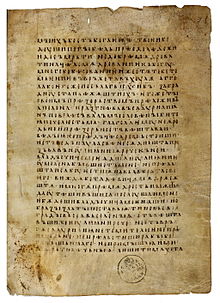- Codex Suprasliensis
-
The Codex Suprasliensis (Polish: Kodeks supraski, Slovene: Supraseljski kodeks; Bulgarian: Супрасълски сборник, Suprasalski sbornik) is an 11th-century Cyrillic literary monument, the largest extant Old Church Slavonic canon manuscript and the oldest Slavic literary work in Poland. As of September 20, 2007 it is on Unesco's Memory of the World list.
The codex contains a menaion for the month of March, intersecting with the movable cycle of Easter. It also contains 24 lives of saints, 23 homilies and one prayer, most of which were written by or are attributed to John Chrysostom. The 284-folio (or 285-folio, according to some sources) codex was "discovered" in 1823 by Canon Michał Bobrowski in the Uniate Basilian monastery in Supraśl.
Upon discovery, Bobrowski sent the manuscript in two pieces to Slovene philologist Jernej Kopitar so that he could publish it: the first part (118 folios) was never returned to Poland and is currently held by the National and University Library of Slovenia in Ljubljana. The largest part was bought for the private library of the Zamoyski family in Warsaw. This part of the codex disappeared during World War II, but later resurfaced in the United States and was returned by Herbert Moeller to Poland in 1968, where it has been held by the National Library of Poland in Warsaw until the present day. The third part, consisting of 16 folios, is held by the Russian National Library in Saint Petersburg.
The codex was published by Fran Miklošič (Vienna, 1851), Sergej Severjanov (Suprasalьskaja rukopisь, Saint Petersburg, 1904), and Jordan Zaimov and Mario Capaldo (Sophia, 1982–1983). Alfons Margulies produced a significant volume on the codex titled Der altkirchenslavische Codex Suprasliensis (Heidelberg, 1927).
Folio 260 of the manuscript contains the note g(ospod)i pomilui retъka amin. Some experts think that this represents the name of a scribe (hence the occasional name Codex of Retko) and that the text was copied from several sources. Research indicates that at least one of the sources may have Glagolitic (for Epiphanius' Homily on the Entombment). Vocalizations of yers, rarely-occurring epenthesis, change of ъ to ь behind hardened č, ž, š and some other linguistic traits point to its Bulgarian linguistic provenance.
References
- Заимов, Й., М. Капалдо, „Супрасълски или Ретков сборник“, том. 1, София, 1982, том. 2, София, 1983.
- Damjanović, Stjepan (2004). Slovo iskona. Zagreb: Matica hrvatska. ISBN 953-150-567-5.
- Schenker, Alexander (1995). The Dawn of Slavic: An Introduction to Slavic Philology. New Haven: Yale University Press. ISBN 0-30005-846-2.
External links
- Codex Suprasliensis manuscript - UNESCO - Memory of the World, at the Institute for Literature, Bulgarian Academy of Sciences
- Codex Suprasliensis transliterated in 7-bit ASCII, at the Corpus Cyrillo-Methodianum Helsingiense
- Codex Suprasliensis, at TITUS project
Categories:- History of Poland
- Eastern Orthodoxy
- Memory of the World Register
- Old Church Slavonic canon
- Medieval Bulgarian literature
Wikimedia Foundation. 2010.

